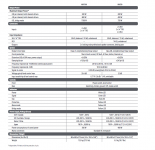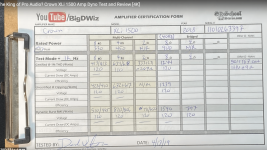Which amplifier would you choose between Crown XLI 1500 and Behringer KM 1700?
Crown XLI 1500 delivers the power stated by the manufacturer and also has some more power reserve.
Behringer KM 1700 specifications only mention a max power rating (peak) and Behringer states that the expected continous power rating should be about half the declared max power rating, so one never knows for sure exactly how much power can deliver continuously into the given load.
Construction wise, Crown XLI 1500 seems to be a class A amplifier with chinese made toroidal transformer (Guangdong NRE Technology) and 4 capacitors of 63V/10000 uF.
Behringer KM 1700 is declared to be a class H amplifier and, as far as I know, it may use the same Chinese suplier for the toroidal transformer (Guangdong NRE Technology) and use 4 capacitors of 63V/10000uF also.
Is there any room for modifications on any of these two amplifiers to improve their performance and reliability?
Thank you kindly!
Crown XLI 1500 delivers the power stated by the manufacturer and also has some more power reserve.
Behringer KM 1700 specifications only mention a max power rating (peak) and Behringer states that the expected continous power rating should be about half the declared max power rating, so one never knows for sure exactly how much power can deliver continuously into the given load.
Construction wise, Crown XLI 1500 seems to be a class A amplifier with chinese made toroidal transformer (Guangdong NRE Technology) and 4 capacitors of 63V/10000 uF.
Behringer KM 1700 is declared to be a class H amplifier and, as far as I know, it may use the same Chinese suplier for the toroidal transformer (Guangdong NRE Technology) and use 4 capacitors of 63V/10000uF also.
Is there any room for modifications on any of these two amplifiers to improve their performance and reliability?
Thank you kindly!
Last edited:
There is a thread is this forum from a couple of years ago about the KM1700. It's worth a read. Power measures about 100-150W into 8R, with up to 500W on brief peaks at higher frequency. Distortion is not particular low but its a PA amplifier. It's well built. I own a couple of these and I like them.
Also, I think you meant to write that the Crown is class AB. It's definitely not class A! I don't have any experience with the XLi amps from Crown, but I imagine it meets its specs (unlike the Behringer's pie in the sky power ratings!).
From that earlier thread, one person added some extra capacitance to the PS and did a couple other minor mods to the KM1700 and says he likes the sound. It's worth investigating that same approach if you can find the amp on sale, etc.
Also, I think you meant to write that the Crown is class AB. It's definitely not class A! I don't have any experience with the XLi amps from Crown, but I imagine it meets its specs (unlike the Behringer's pie in the sky power ratings!).
From that earlier thread, one person added some extra capacitance to the PS and did a couple other minor mods to the KM1700 and says he likes the sound. It's worth investigating that same approach if you can find the amp on sale, etc.
Thank you for answering!
I already read the existing thread about the KM 1700 and also other sources, but the test results were different (higher power delivered) from what was said in this forum.
Given the fact that both Behringer KM 1700 and Crown XLI 1500 have identical specifictions capacitors (63V / 10000uF), I would suspect that Behringer KM 1700 toroidal transformer is weaker than the toroidal transformer of the Crown XLI 1500.
Anyway, the reason I asked is because I want to power two floorstanding speakers rated 165W continous / 330W peak at 6 ohms and I would like to ensure at least 3 dB of headroom between the speakers continuous power capacity and the amplifier continous power capabilities at 6 ohms.
It seems that the Crown XLI 1500 will be able to do the job without missing a beat.
I already read the existing thread about the KM 1700 and also other sources, but the test results were different (higher power delivered) from what was said in this forum.
Given the fact that both Behringer KM 1700 and Crown XLI 1500 have identical specifictions capacitors (63V / 10000uF), I would suspect that Behringer KM 1700 toroidal transformer is weaker than the toroidal transformer of the Crown XLI 1500.
Anyway, the reason I asked is because I want to power two floorstanding speakers rated 165W continous / 330W peak at 6 ohms and I would like to ensure at least 3 dB of headroom between the speakers continuous power capacity and the amplifier continous power capabilities at 6 ohms.
It seems that the Crown XLI 1500 will be able to do the job without missing a beat.
Yeah nobody makes a class A pro amplifier.. too inefficient, it will be class AB. Class H is also usually a class AB design with high/low switching voltage rails to increase output power and reduce power consumption.
If the Behringer specs could be believed these two amps should perform very similarly with music since the peaks(burst) output capacity of an amp is usually the limiting factor in how loud it will play, the continuous average of even the most compressed music is rarely less than 6dB below peak and more often 12dB down or more, so while sinewave tests are a valid reference it doesn't tell you the whole picture.
That said the Crown exceeded specs in the online bench test for both sine wave and burst output while I didn't see anything for the Behringer and the company is well known for embelishing power output specs.
If the Behringer specs could be believed these two amps should perform very similarly with music since the peaks(burst) output capacity of an amp is usually the limiting factor in how loud it will play, the continuous average of even the most compressed music is rarely less than 6dB below peak and more often 12dB down or more, so while sinewave tests are a valid reference it doesn't tell you the whole picture.
That said the Crown exceeded specs in the online bench test for both sine wave and burst output while I didn't see anything for the Behringer and the company is well known for embelishing power output specs.
Yes, I ment to write class AB, but I typed class A, instead.think you meant to write that the Crown is class AB
I also opened a support ticket on Behringer support staff and their answer was as follows:
"The 200W is the peak power not the RMS, the calculation should based on the RMS 130W for KM750 and 310W for KM1700.
Also the peak power is actually about 210W for KM750."
After a few days, when I asked for more details about Behringer KM 1700 continous power capabilities, the toroidal transformer output voltages and currents, Behringer evaded to answer specifically and returned to their policy disc stating: "We no longer list our amp power ratings by RMS as these tend to not give true results as tests are always done using signal generators and specific waveforms which don't reflect in comparison to music, music comes at fuller frequencies and non linear dynamics which of course as I'm sure you're aware is nothing like a test tone generated from a signal generator...As a rule of thumb, you can assume RMS is around half the peak value."
Behringer are pretty ridiculous in daring to use the word "assume" when speaking about a power amplifier capability to fry a tweeter or to melt a voicecoil, not to mention the fact that a customer should be able to make some pretty educated calculations when he's putting together a sound system.
Last edited:
The fine print in the KM1700 specs also says the power ratings are "independent of limiters and driver protection circuits", with no distortion figures, though the specs claim "<0.03% at 50% max power".I also opened a support ticket on Behringer support staff and their answer was as follows:
"The 200W is the peak power not the RMS, the calculation should based on the RMS 130W for KM750 and 310W for KM1700.
Also the peak power is actually about 210W for KM750."

Given that, and your support ticket answer, what Thomass77 wrote: "This amp has a continuous output of approx. 125 wpc with 6 dB of dynamic headroom to yield 500w on peaks" seems to be more believable.
Williston Audio's tests of the Crown XLi 1500 show it delivering more than it's guaranteed minimum RMS power ratings.

Knowing that both Behringer KM 1700 and Crown XLI 1500 use 4 power supply capacitors of 10000 uF / 63 V, it would seem that Behringer KM 1700 weakness is the toroidal transformer which is unable to sustain continous power figures similar to Crown XLI 1500.
Maybe someone can provide some feedback about Behringer KM 1700 toroidal transformer specifications (primary windings voltages, secondary windings voltages and currents, apparent power rating).
Maybe someone can provide some feedback about Behringer KM 1700 toroidal transformer specifications (primary windings voltages, secondary windings voltages and currents, apparent power rating).
Last edited:
Have you considered modern class D amps?
The Crown XLS1502 has similar specs to a XLi1500, but weighs less than half and uses less electricity.
The Crown XLS1502 has similar specs to a XLi1500, but weighs less than half and uses less electricity.
Last edited:
I use active speakers with built-in class D amplifiers, when I need high power high SPL amplification with good mobility.
For fixed installations, like inside a room, I like simple and reliable class AB amplification, no matter how powerful or how heavy.
In both situations, live (mobile) or inside the house I use speakers management systems with high sample rate / high bit depth digital signal processing.
For fixed installations, like inside a room, I like simple and reliable class AB amplification, no matter how powerful or how heavy.
In both situations, live (mobile) or inside the house I use speakers management systems with high sample rate / high bit depth digital signal processing.
Behringer KM1700 benefits from better quality (lower ESR) PSU capacitors. Std. SLPX123M063E9P3 (12mfd/63VDC) actually
made a difference at lower frequencies, about 12% for what it´s worth.
made a difference at lower frequencies, about 12% for what it´s worth.
- Home
- Live Sound
- PA Systems
- Crown XLI 1500 vs Behringer KM 1700